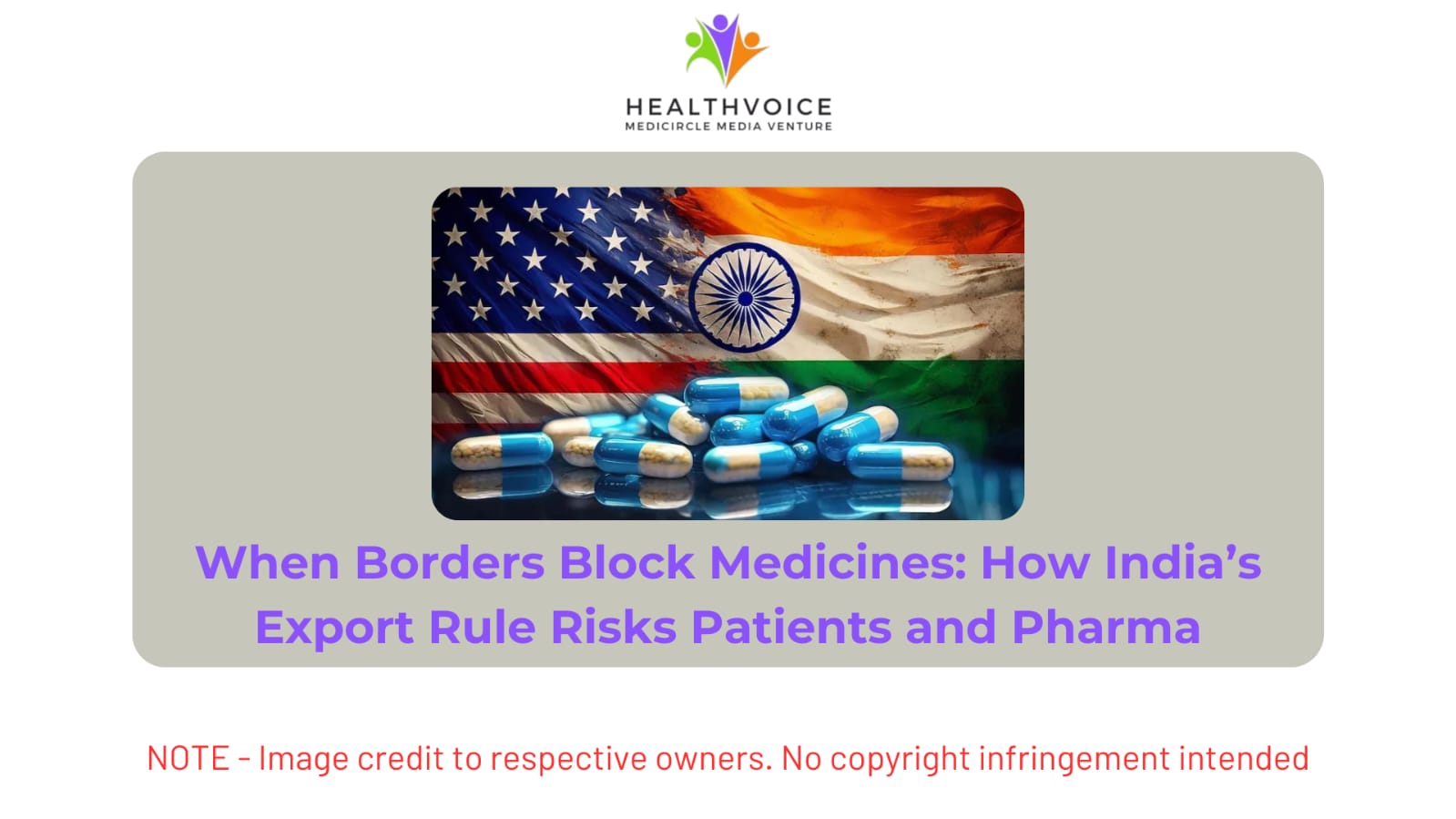When Borders Block Medicines: How India’s Export Rule Risks Patients and Pharma
India’s pharmaceutical journey has always been about breaking barriers of affordability and access.

In the global world of medicine, India has always been known as the pharmacy of the developing nations. Generations of patients across continents have looked towards Indian pharmaceutical companies to supply them with affordable, high-quality medicines that save lives. From oncology drugs to life-saving treatments for rare enzyme deficiencies, from autoimmune therapies to critical antibiotics, Indian medicines have been a backbone of healthcare in countries where imported drugs from Western markets remain unaffordable. But a new rule introduced by India’s drug regulatory authority threatens to change this position drastically, putting not only exporters but also patients at risk of losing access to essential care.
The circular that came into effect last year restricts the export of medicines marked with the label “For sale in India only.” On the surface, it may look like a small regulatory clause, but in practice, it has disrupted the entire pharmaceutical export ecosystem. Merchant exporters who have for decades been sending these medicines to patients abroad suddenly find themselves blocked by this rule. The Federation of Pharmaceutical and Allied Products Merchant Exporters (FPME), representing this community, has already raised alarm bells, writing to both the health ministry and commerce ministry to repeal the restriction. According to their estimates, the losses are already at $500 million, and the situation is worsening with every passing month. The figure may sound like a balance sheet problem, but it actually represents the erosion of India’s global competitiveness in pharmaceuticals and the growing despair of patients abroad who depend on India for affordable medicines.
India’s pharmaceutical industry is one of the few sectors where the country commands global respect. It is built on the promise of quality medicines at a fraction of the price demanded by multinational giants. This advantage has historically helped India supply cancer drugs, HIV medicines, immunosuppressants, and therapies for chronic and rare diseases to both developed and developing nations. Patients traveling for medical tourism, a growing trend in India, have also benefited, often carrying these medicines back home to continue treatment. Families of Indian origin living abroad relied on exporters to source drugs that were otherwise unaffordable in their adopted countries. All of this was possible because the export of such medicines was permitted under the existing framework of laws, including the Customs Act and the Foreign Trade Act. But the new restriction on “For sale in India only” products has abruptly broken this chain, leaving exporters unable to fulfill orders and patients stranded without supply.
The government’s explanation has been that the restriction was needed to prevent the diversion of medicines meant for the domestic market. Officials argue that the “For sale in India only” label exists under patent law to ensure that the product is consumed within Indian territory, where the patent holder’s rights apply. In their view, allowing exports under this label could lead to violations of intellectual property protections. But this argument leaves too many gaps unanswered. Firstly, no other major pharmaceutical exporting nation follows such a blanket restriction. Secondly, the law already provides remedies for genuine misuse under customs and trade provisions. Thirdly, the humanitarian implications of the restriction outweigh the theoretical risk of diversion. If the result of the rule is both loss of foreign exchange and denial of medicines to patients abroad, then surely the balance of harm lies in maintaining the earlier export flexibility.
There is also a question of timing. India has been positioning itself as a hub for global health partnerships, playing a critical role in vaccine distribution during the COVID-19 pandemic and strengthening its image as a dependable healthcare partner. Just when the world is expecting India to expand its leadership in generic medicines, such restrictive rules send the opposite message. Losing $500 million in exports is not merely an economic statistic; it represents lost markets, lost goodwill, and lost opportunities for Indian pharma companies who are competing fiercely against Chinese and Western players. Once those markets turn elsewhere, winning them back will not be easy.
When rules designed for intellectual property compliance begin to deny medicines to patients, something has gone wrong in the regulatory balance. Medicines are not like any other product; they are not luxury commodities but essential goods tied to life and death. India has built its global reputation precisely on recognising this distinction, championing affordable access against the monopoly of patents. The same principle underpinned India’s fight at the World Trade Organization for access to affordable antiretrovirals during the HIV/AIDS crisis. To suddenly undermine this hard-won reputation with a rule that chokes exports is a contradiction to India’s own legacy.
FPME has rightly pointed out that this restriction is unique to India. No other country imposes such a blanket ban on exporting medicines labeled for domestic sale. Exporters argue that earlier frameworks already balanced domestic availability with international supply without such disruptions. Now, long-established products that were consistently exported face sudden roadblocks, creating backlogs, breaking trust with foreign buyers, and opening space for counterfeiters. It is not just about money, it is about global credibility.
The plea from exporters to the ministries is to keep patients at the heart of the policy. The call is not to abolish safeguards against misuse but to adopt a more balanced mechanism that prevents diversion without stopping legitimate exports. Possible solutions could include stronger monitoring systems, clearer documentation trails, or special export permissions for medicines proven to be in demand abroad. What exporters resist is the blunt instrument of a total restriction, which punishes the genuine for fear of the dishonest.
The issue also brings into focus the future of India’s pharmaceutical policy. The sector has always walked a fine line between respecting intellectual property rights and ensuring public health needs are met. This rule risks tilting the balance too far in one direction, undermining India’s long-standing philosophy that lifesaving medicines should not be priced beyond reach. If left unchecked, it could set a precedent where corporate patents dictate global access, eroding the very foundation of India’s healthcare diplomacy.
The need of the hour is dialogue and revision. The ministries of health and commerce must listen carefully to the warnings from FPME and other stakeholders. The losses are mounting not just in dollars but in trust and human lives. A policy review that restores the ability of exporters to serve legitimate foreign demand, while still protecting against diversion, is urgently needed. Perhaps a special committee could be formed to evaluate the humanitarian consequences of such rules, involving medical experts, patient groups, and international health partners. After all, regulations should serve people, not strangle them.
India’s pharmaceutical journey has always been about breaking barriers of affordability and access. It is this very ethos that made Indian doctors and pharma companies global heroes during the darkest days of the pandemic. The current export restriction stands in sharp contrast to that legacy. By reconsidering it, India has a chance to reaffirm its commitment to global health justice.
 Sunny Parayan
Sunny Parayan
#healthvoice #AffordableMedicines #AccessToHealthcare #HealthJustice #IndianPharma #MedicinesWithoutBorders #HealthcareForAll #DrugExport #PharmaCrisis #HealthcareLeadership #StopRevenueLoss #EssentialMedicines
